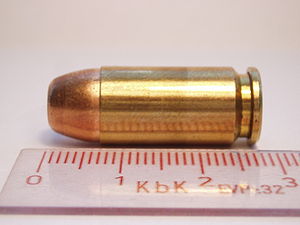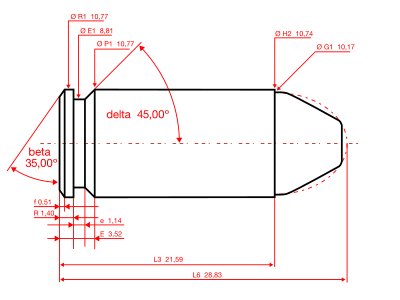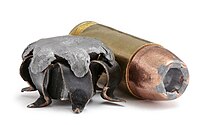
The .38 Special, also commonly known as .38 S&W Special, .38 Smith & Wesson Special, .38 Spl, .38 Spc, or 9x29mmR is a rimmed, centerfire cartridge designed by Smith & Wesson.

The .45 ACP, also known as .45 Auto, .45 Automatic, or 11.43×23mm is a rimless straight-walled handgun cartridge designed by John Moses Browning in 1904, for use in his prototype Colt semi-automatic pistol. After successful military trials, it was adopted as the standard chambering for Colt's M1911 pistol. The round was developed due to a lack of stopping power experienced in the Moro Rebellion in places like Sulu. The issued ammunition, .38 Long Colt, had proved inadequate, motivating the search for a better cartridge. This experience and the Thompson–LaGarde Tests of 1904 led the Army and the Cavalry to decide that a minimum of .45 caliber was required in a new handgun cartridge.

The .380 ACP, is a rimless, straight-walled pistol cartridge developed by firearms designer John Moses Browning. The cartridge headspaces on the mouth of the case. It was introduced in 1908 by Colt, for use in its new Colt Model 1908 pocket hammerless semi-automatic, and has been a popular self-defense cartridge ever since, seeing wide use in numerous handguns. Other names for .380 ACP include .380 Auto, 9×17mm, 9mm Browning, 9mm Corto, 9mm Kurz, 9mm Short, and 9mm Browning Court. It should not be confused with .38 ACP. The .380 ACP does not strictly conform to cartridge naming conventions, named after the diameter of the bullet, as the actual bullet diameter of the .380 ACP is .355 inches.

The .45 GAP or .45 Glock (11.43×19mm) is a pistol cartridge designed by Ernest Durham, an engineer with CCI/Speer, at the request of firearms manufacturer Glock to provide a cartridge that would equal the power of the .45 ACP, have a stronger case head to reduce the possibility of case neck blowouts, and be shorter to fit in a more compact handgun. The .45 GAP is the first commercially introduced cartridge that has been identified with Glock.

The .357 SIG is a bottlenecked rimless centerfire handgun cartridge developed by the Swiss-German firearms manufacturer SIG Sauer, in cooperation with ammunition manufacturer Federal Premium. The cartridge is used by a number of law enforcement agencies.
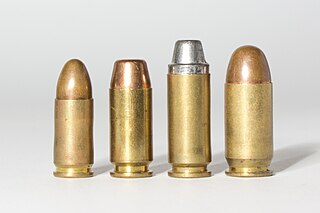
The 9×19mm Parabellum is a rimless, centerfire, tapered firearms cartridge.
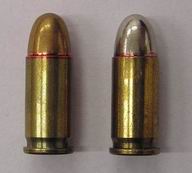
.32 ACP is a centerfire pistol cartridge. It is a semi-rimmed, straight-walled cartridge developed by firearms designer John Browning, initially for use in the FN M1900 semi-automatic pistol. It was introduced in 1899 by Fabrique Nationale, and is also known as the 7.65 mm Browning Short.

The .38 Super, also known as .38 Super Auto, .38 Super Automatic, .38 Super Automatic +P , .38 Super +P , or 9×23mmSR, is a pistol cartridge that fires a 0.356-inch-diameter (9.04 mm) bullet. It was introduced in the late 1920s as a higher pressure loading of the .38 ACP, also known as .38 Auto. The older .38 ACP cartridge propels a 130-grain (8.4 g) bullet at 1,050 ft/s (320.0 m/s), whereas the .38 Super pushes the same bullet at 1,280 ft/s (390.1 m/s). The .38 Super has gained distinction as the caliber of choice for many top practical shooting competitors; it remains one of the dominant calibers in IPSC competition.

The 10mm Auto is a powerful and versatile semi-automatic pistol cartridge introduced in 1983. Its design was adopted and later produced by ammunition manufacturer FFV Norma AB of Åmotfors, Sweden.

The .44 Smith & Wesson Special, also commonly known as .44 S&W Special, .44 Special, .44 Spl, .44 Spc, or 10.9×29mmR, is a smokeless powder center fire metallic revolver cartridge developed by Smith & Wesson in 1907 as the standard chambering for their New Century revolver, introduced in 1908.

The 7.62×25mm Tokarev cartridge is a Soviet rimless bottleneck pistol cartridge widely used in former Soviet states and in China, among other countries. The cartridge has since been replaced in most capacities by the 9×18mm Makarov in Russian service.
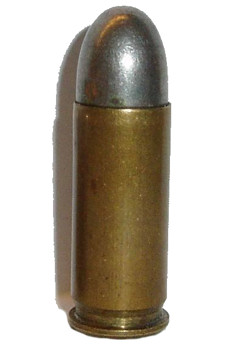
The .38 ACP, also known as the .38 Auto, .38 Automatic, or 9x23mmSR, is a semi-rimmed pistol cartridge that was introduced at the turn of the 20th century for the John Browning-designed Colt M1900. It was first used in Colt's Model 1897 prototype, which he did not produce. The metric designation for the round is 9×23mm SR (semi-rimmed), which is not to be confused with other 9×23mm cartridges.

The .400 Corbon (10.2x22mm) is an automatic pistol cartridge developed by Cor-Bon in 1997. It was created to mimic the ballistics of the 10 mm Auto cartridge in a .45 ACP form factor.

The .50 GI (12.7×23mmRB) pistol cartridge was developed by Alex Zimmermann of Guncrafter Industries. The .50 GI was introduced at the 2004 SHOT Show alongside the Guncrafter Industries Model No. 1, a variation of the M1911. The round has a rebated rim that is the same diameter as that of the .45 ACP.

The .32 H&R Magnum, also known as the .32 Magnum, is a rimmed cartridge designed for use in revolvers. It was developed and introduced in 1984 as a joint venture between Harrington & Richardson and Federal Premium Ammunition.

Overpressure ammunition, commonly designated as +P or +P+, is small arms ammunition that has been loaded to produce a higher internal pressure when fired than is standard for ammunition of its caliber, but less than the pressures generated by a proof round. This is done typically to produce ammunition with higher muzzle velocity, muzzle energy, and stopping power, such as ammunition used for security, defensive, or hunting purposes. Because of this, +P ammunition is typically found in handgun calibers which might be used for paramilitary forces, armed security, and defensive purposes.

The .41 Action Express is a pistol cartridge developed in 1986 to reproduce the performance of the .41 Magnum police load in semi-automatic pistols.

The 9×23mm Winchester is a pistol cartridge developed as a joint venture by Winchester Ammunition and Colt's Manufacturing Company. The 9×23mm Winchester has a convoluted development history, but was commercially introduced by Winchester in 1996. Marketed primarily to competition shooters as a replacement for .38 Super for International Practical Shooting Confederation, United States Practical Shooting Association and International Defensive Pistol Association competition, the cartridge failed to find significant market success despite a high-profile introduction.
The .356 TSW is a centerfire pistol cartridge designed by Smith & Wesson in the early-1990s.
The .40 Super (10.2x25mm) is a powerful automatic pistol cartridge developed through the collaboration of Fernando Coelho and Tom Burczynski and introduced by Triton Cartridge in 1996. It delivers ballistics comparable to the .41 Magnum revolver cartridge, yet functions in standard 1911s and other full-size pistols. A 5” 1911 chambered in the cartridge is capable of penetrating 46” of Clear Ballistics gel.
